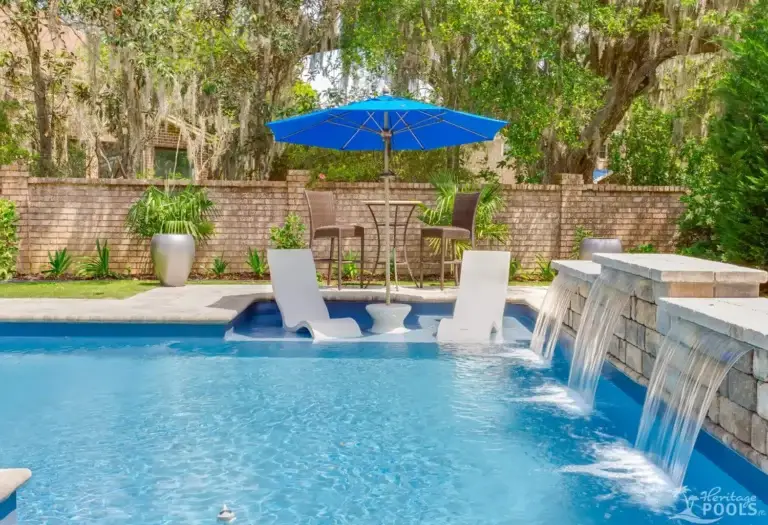If you’re wondering how to shock a pool, you’ve come to the right place! In this blog post, we’ll provide a comprehensive guide on how to shock a pool the right way. We’ll cover the reasons why you should shock your pool, the chemicals you’ll need, and the specific steps you should take to get the job done correctly. By following our instructions, you can keep your pool water healthy and safe for everyone to enjoy.

Why You Should Shock Your Pool
Shocking your pool is an important part of pool maintenance and it’s a great way to make sure your swimming pool stays clean, clear and bacteria free. But what exactly does it mean to shock a pool?
Shocking a pool means adding chlorine to the water to eliminate bacteria and algae. When the chlorine level in your pool is too low, it can allow algae and bacteria to flourish, which can cause the water to turn green and cloudy. To help keep your water clean and clear, you need to shock your pool by increasing the level of chlorine in your water.
When to Shock Your Pool
It is especially important to shock your pool regularly if you use it often or if you live in a hot climate, like Charleston.
When deciding when to shock your pool, you should consider the following: the current pH levels, the level of chlorine in the pool, and the clarity of the water. If the pH levels are too high or the chlorine levels are too low, then you should shock your pool right away. If the water looks cloudy or has an unpleasant odor, it’s also time to shock your pool.
Shocking your pool is an important part of pool maintenance and it should be done at least once a month to keep your pool healthy and looking its best. With the right amount of liquid chlorine, you can easily and quickly shock your pool back into shape.

How to Shock Your Pool
Shocking your pool involves adding a large amount of chlorine to raise the chlorine levels in the pool to an effective level. This helps to kill any bacteria or algae that may have been growing in the pool.
When it comes to how much liquid chlorine to add to your pool, it depends on the size of your pool and the current chlorine level. Generally, you will need between 1-3 gallons of liquid chlorine per 10,000 gallons of water in the pool.
If your pool has recently turned green, shock treatments are necessary to restore its cleanliness. Start by testing the chlorine levels of your pool with a testing kit. If the chlorine level is below 3 ppm (parts per million), add enough liquid chlorine until the reading reaches between 5-10 ppm. Wait for 24 hours, then test again. If the chlorine level is still low, add more chlorine until it reaches 5-10 ppm.
Start by skimming any debris from the surface of the pool and brushing down the walls. Once the water is prepped, add the recommended amount of liquid chlorine and let it circulate through the filter system for several hours. Test the chlorine level again after a few hours and adjust as needed.
Once the chlorine levels are up, you will need to brush your pool walls and floor to remove any debris that may have built up. You can also use an algaecide to help remove algae build up. After shocking your pool, make sure you run your filter for 24 hours to get rid of any remaining contaminants.

Pool Shock Chemicals
By adding certain chemicals, called oxidizers, to the pool, you are effectively killing bacteria and other contaminants. The most common type of oxidizer used to shock a pool is liquid chlorine.
When it comes to how much liquid chlorine to add to your pool, there are several factors that come into play. The size of the pool and its current sanitizer levels are two important factors that will determine how much chlorine should be added. It’s important to note that if the pool’s sanitizer level is already low, adding too much chlorine could cause it to reach unsafe levels. If you’re unsure how much chlorine to add to your pool, consult a professional to get the correct amount.
For pools that have turned green due to an abundance of algae, a shock treatment using liquid chlorine can help reduce the amount of algae present. The amount of chlorine needed in this case will depend on the severity of the algae infestation. Generally speaking, for a mild case of algae growth, you will need about 4 gallons of liquid chlorine for every 10,000 gallons of water. For more severe cases, up to 8 gallons per 10,000 gallons may be needed. After adding the liquid chlorine, you should also add a strong algaecide to help kill off any remaining algae spores.
Before you shock your pool, be sure to test the pH levels and adjust them as needed. Chlorine has a higher pH than other chemicals, so if your pH is too low, it will cause the chlorine to dissipate quickly. You want to make sure the pH levels are balanced before adding the shock.
Once you’ve added the shock and balanced the pH levels, be sure to circulate the pool water for at least two hours. This will ensure that the shock is properly distributed throughout the entire pool. After two hours, check the chlorine levels and make sure they’re in the appropriate range before allowing anyone to swim in the pool.
Pro Note:Heritage Pools recommends staying out of the pool for a minimum of eight hours. They suggest shocking the pool at night to prevent any delays in swim time.

Summary Steps for Shocking Your Pool
Once you’ve determined how much liquid chlorine to add to your pool and you know how to shock a pool that is green, there are a few additional tips to keep in mind.
Firstly, be sure to brush the walls and floor of the pool before you begin the shocking process. This will help ensure that the chlorine reaches every nook and cranny of the pool, so it can effectively combat any algae or bacteria.
Secondly, make sure to leave the pump and filter running throughout the entire process. This will help circulate the chlorine evenly throughout the water and expedite the process of cleaning the pool.
Finally, remember to test the pH and alkalinity levels before shocking the pool. Ideally, your pH should be between 7.2 and 7.8, and alkalinity should be between 80 and 120 ppm. If your pH is too low, you can use sodium bicarbonate to raise the alkalinity. If your pH is too high, you can use muriatic acid or sodium bisulfate (dry acid) to lower the alkalinity.
By following these simple tips, you’ll be able to shock your pool like a pro!

Professional Service
If you want to ensure your pool is clean and safe to swim in, it’s important to learn how to properly shock a pool. Unfortunately, this can be a difficult task for those who are inexperienced with pool care. That’s why it’s always a good idea to hire a professional pool maintenance service to help you with the job.
At Heritage Pools, we have decades of experience in pool maintenance and are here to help you understand the process of shocking your pool.




